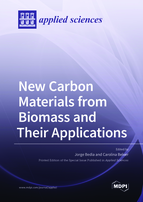New Carbon Materials from Biomass and Their Applications
A special issue of Applied Sciences (ISSN 2076-3417). This special issue belongs to the section "Materials Science and Engineering".
Deadline for manuscript submissions: closed (30 April 2020) | Viewed by 81834
Special Issue Editors
Interests: chemical engineering; metal–organic frameworks (MOFs); carbon materials; water treatment; adsorption; advanced oxidation processes (AOPs); photocatalysis
Special Issues, Collections and Topics in MDPI journals
Interests: chemical engineering; materials science; adsorption; photocatalysis; semiconductors; MOFs
Special Issues, Collections and Topics in MDPI journals
Special Issue Information
Dear Colleagues,
Carbon-based materials, such as chars, activated carbons, one-dimensional carbon nanotubes, and two-dimensional graphene nanosheets, have shown great potential for a wide variety of applications. These materials can be synthesized from any precursor with a high proportion of carbon in its composition. Although fossil fuels have been extensively used as precursors, their unstable cost and supply have led to the synthesis of carbon materials from biomass. Biomass covers all forms of organic material, including plants both living and in waste form, and animal waste products. It appears to be a renewable resource because it yields value-added products prepared using environmentally-friendly processes. The application of these biomass-derived carbon materials include electronic, electromagnetic, electrochemical, environmental and biomedical applications. Thus, novel carbon materials from biomass are a subject of intense research, with strong relevance to both science and technology. The main aim of this Special Issue of Applied Sciences (ISSN 2076-3417) is to present the most relevant and recent insights in the field of the synthesis of biomass-derived carbons for sustainable applications, including adsorption, catalysis and/or energy storage applications. Some of the key topics relevant to this Special Issue are:
- Synthesis and applications of hydrochars from the hydrothermal carbonization of biomass.
- Preparation and characterization of biomass-derived activated carbons for adsorption processes with special attention to the removal of emerging contaminants and heavy metals.
- Synthesis of carbon-based materials from biomass as bulk catalysts or supports for catalysis or photocatalysis.
- Energy storage in carbon materials obtained from biomass.
- Biomass-derived carbons for batteries.
- Porous carbons materials obtained from biomass for carbon dioxide capture.
We look forward to your submission.
Prof. Jorge Bedia
Prof. Carolina Belver
Guest Editors
Manuscript Submission Information
Manuscripts should be submitted online at www.mdpi.com by registering and logging in to this website. Once you are registered, click here to go to the submission form. Manuscripts can be submitted until the deadline. All submissions that pass pre-check are peer-reviewed. Accepted papers will be published continuously in the journal (as soon as accepted) and will be listed together on the special issue website. Research articles, review articles as well as short communications are invited. For planned papers, a title and short abstract (about 100 words) can be sent to the Editorial Office for announcement on this website.
Submitted manuscripts should not have been published previously, nor be under consideration for publication elsewhere (except conference proceedings papers). All manuscripts are thoroughly refereed through a single-blind peer-review process. A guide for authors and other relevant information for submission of manuscripts is available on the Instructions for Authors page. Applied Sciences is an international peer-reviewed open access semimonthly journal published by MDPI.
Please visit the Instructions for Authors page before submitting a manuscript. The Article Processing Charge (APC) for publication in this open access journal is 2400 CHF (Swiss Francs). Submitted papers should be well formatted and use good English. Authors may use MDPI's English editing service prior to publication or during author revisions.
Keywords
- Carbon
- Biomass
- Adsorption
- Catalysis
- Photocatalysis
- CO2 capture
- Energy storage
- Batteries







